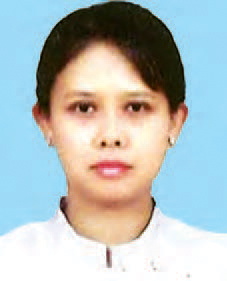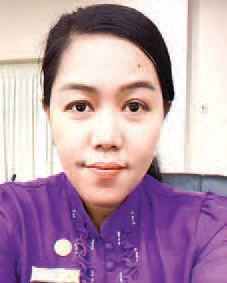Interviewed by Shin Min
Dr. Khin Khin Gyi (Deputy Director)
(Central) Contagious Disease Prevention and Eradication Sub-Department
Department of Public Health
Q: At the moment it was known that there were six fatalities from H1N1 and there were some patients suspected of having the disease. First, let us know about the status of the disease occurrence.
A: Seasonal influenza is a respiratory infection caused by influenza viruses that spread rapidly from one person to another. There are 3 types of seasonal influenza viruses type A, B, and C. In the occurrence process of seasonal influenza, it was found to be caused by Subtype A (H1N1) pdm09 of Seasonal Influenza Virus Type A.
According to news and information received by 20 June 2019, there were 22 patients infected with seasonal influenza of which six patients were Influenza B not determined. 16 patients were found with Seasonal Influenza Subtype A (H1N1) pdm09. Most of the patients were in the age group of 15 to 65 years and to date there were six fatalities.
Five of the fatalities were from Yangon Region while one was from Sagaing Region. Most occurrences were in Yangon Region. There have also been occurrences in Shan State (North), Sagaing Region, Rakhine State and Nay Pyi Taw too.
Q. What has been done by Ministry of Health and Sports on prevention and treatment of it?
A. Whenever a suspected patient of seasonal influenza has been found State/Region Public Health departments are to provide treatments in rural public health clinics and sub rural public health clinics.
At the moment patients with Severe Acute Respiratory Infections (SARI) were to be transferred to the nearest hospitals. In order to prevent infection from suspected patients and SARI patients, persons taking care of the patients were informed about do’s and don’ts.
If a cluster of suspected patients were found patients with Influenza-like illness (ILI) were treated as outpatients while SARI patients were transferred and treated in hospitals.
At least five out of the suspected patients in a Cluster were to be given a Rapid Diagnosis Test with Nasopharyngeal Swab. If A (H1N1) pdm09 was found the Nasopharyngeal Swab sample was to be sent to the National Health Laboratory for confirmation.
To prevent the spreading of disease, suspected patients were kept in an isolated room where they live, urged to rest for up to seven days and avoid going to public places.

Dr. Phyu Phyu Aye (Director)
Health Education and Promotion Sub-Department
Department of Public Health
Q: A meeting was held this morning (20 June) at Ministry of Health and Sports. All in the meeting discussed about prevention and treatment. What was decided at the meeting?
A: A coordination meeting led by Union Minister for Health and Sports Dr. Myint Htwe to reinforce the monitoring, prevention and effective response work was held at the Ministry of Helath and Sports meeting hall 4 today (20 June). Monitoring and response works, the status of occurrences and fatalities, laboratory test matters and publishing true news to reduce public concerns were discussed.
Q: What are the symptoms of the disease and do’s and don’ts for the public?
A: Disease symptoms were fevers above 38 degree centigrade, cough, sore throat, runny or stuffy nose, muscle or body aches, headaches and fatigue (tiredness). If the disease is severe, there’ll be high fever, extreme coughing, fatigue, difficulty to breath, high rate of breathing, dizziness, confusion, and fainting.
Much care must be taken toward personal hygiene. Cover your cough or sneeze. Wash your hands frequently with plenty of soap and water. Sleep and rest well. Take nutritious food and conduct regular physical activities. Stay where you can have good air to breath. Avoid public places and crowded areas. If symptoms of the disease show up in you, take treatment at the nearest health department.
Q: Can the disease prevented by vaccines?
A: Seasonal influenza vaccines protect only 46 percent from the occurrence. World Health Organization and most of the countries in the world hadn’t suggested or recommended taking seasonal influenza vaccines. But if you want to take it, consult and take it at the nearest hospital and clinic.
Q: Seasonal influenza occurs back in 2017. What is the difference between then and now?
A: After the outbreak of seasonal influenza in 2017 Ministry of Health and Sports, Department of Public Health, (Central) Contagious Disease Prevention and Eradication Sub-Department reinforced ILI/SARI Surveillance works by designating Yangon People’s Hospital, Thingangyun Model Teaching and General Hospital, Nay Pyi Taw 1000-bed General Hospital, Myitkyina People’s Hospital, Myawady People’s Hospital, Muse People’s Hospital, Mandalay People’s Hospital and Sittway People’s Hospital as Sentinel Site and diseases monitoring works were conducted starting from 2018 April.
Response work will be conducted on the basis of experience gained in the occurrence of Seasonal Influenza A (H1N1) pdm09 from 21 June to 19 August 2017. At that time there were 1,198 respiratory infection patients out of which 400 were found with Seasonal Influenza A (H1N1) and 49 were found with H3N2. There were 38 fatalities and the fatality rate was found to be 3.17 percent.
Thanks for answering.
(Translated by Zaw Min)


